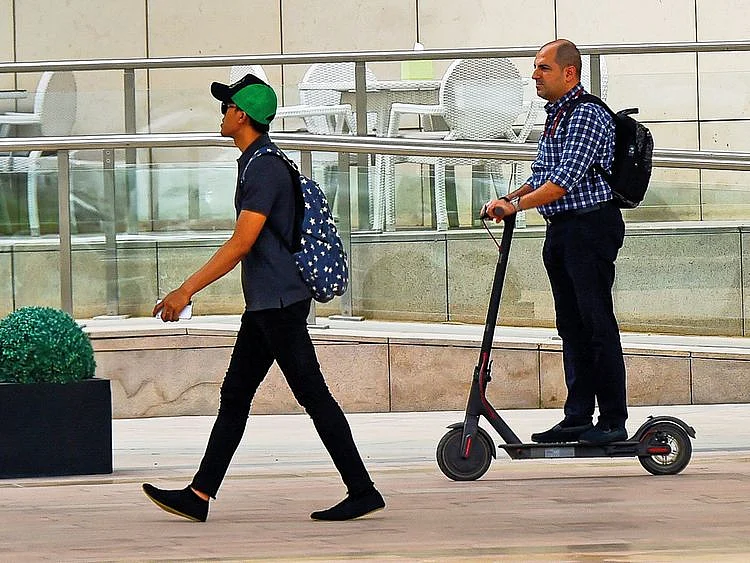What are the new laws for electric scooter and bicycle riders in UAE?
Abu Dhabi has banned electric scooters with seats; Dubai has stipulated rider permits

Abu Dhabi: As the UAE continues to offer better and more accessible options for public transport, a number of residents have switched to smaller and more eco-friendly modes of private transport.
In particular, there has been a surge in the number of people using bicycles and electric scooters to get around. These vehicles represent a convenient mode of transport, particularly over shorter distances. In light of rising fuel prices, they also offer more cost-effective options.
However, a recent spate of accidents has seen serious injuries and at least two fatalities among riders, prompting traffic authorities to launch a nationwide campaign on bicycle and electric scooter safety.
In Abu Dhabi, authorities have now banned the use of electric scooters with seats and urged riders to ride electric scooters while standing upright. Pillion riding is also banned on both types of vehicles across the UAE, unless the bicycle is equipped with a dedicated pillion seat and safety gear.
Traffic officials held a media briefing in Dubai earlier this month and authorities in Abu Dhabi — including Abu Dhabi Police and public transport regulator, the Department of Municipality and Transport’s Integrated Transport Centre (ITC) — reached out to scooter and bicycle riders with safety leaflets and helmets. In addition to increasing safety awareness, officials have also highlighted the penalties to be imposed on offenders.
Safety regulations
Here are all the safety regulations that must be followed if you are riding an electric scooter or bicycle in the UAE:
What to wear
Always wear a protective helmet and reflective jacket when riding. Only use the authorised types of bikes and electric scooters.
Bicycles can have two or more wheels, but must not have an electric motor.
Electric scooters can have two or more wheels and an electric motor, but they cannot include a seat and must be driven in an upright manner. In fact, electric scooters with seats are now prohibited in Abu Dhabi.
What to install
Make sure the following elements are installed: A white headlight, a red night light or reflector and a red rear light connected to the brakes.
Make sure to install a bike horn connected to the handlebars, which should be used to warn other pedestrians and riders of your approach.
Where to ride
For your safety and the safety of others, use your electric scooter or bicycle in designated areas only — internal roads with speed limits less than 40 kilometres per hour, or on bike paths.
Do not ride bicycles and electric scooters on public roads and highways, avoid pedestrian lanes.
If there is no bike lane, ride on the far right of the internal road.
Do not ride at high speeds that can increase the risk of falls. The maximum speed for electric scooters and bicycles is set at 20 kilometres per hour.
How to ride
On crowded paths, reduce your speed and look out for other road users.
To avoid accidents, make sure you always leave sufficient distance between you and other cyclists or pedestrians around you.
Ride in the direction of the track or road that you are on.
Do not carry pillion riders (passengers) on these vehicles, which are meant for single riders only.
Avoid carrying heavy weights that can interfere with your balance.
Avoid distractions while riding.
Comply with safety regulations and do not attempt to perform stunts while riding.
Where to park
When parking the bicycle or electric scooter, make sure to use the designated stands. Do not secure bicycles and electric scooters to street lights or sign posts.
Permits
Riding on unauthorised roads and areas, including on a main road used by vehicles, or a walking and running track.
Riding on the hard shoulder along highways or roads where the speed limit is more than 40 kilometres per hour.
Fines and penalties
Fines and penalties: The ITC has released the following penalties that can be imposed on bicycle and electric scooter riders. Dh200 fine for each of these violations: Riding on the main road. Failure to follow the direction of the road, or instructions on traffic signs. Failure to wear a protective helmet. Failure to wear a jacket or reflective clothing while riding in dark areas. Parking the bicycle or electric scooter in a non-designated space in a manner that hinders the movement of vehicles or pedestrians. Leaving bicycles and electric scooters secured to street lights or sign posts. Failing to give way to pedestrians at intersections and sidewalks. Failing to slow down at pedestrian crossings or riding across a pedestrian crossing without dismounting from the bicycle or electric scooter. Failing to ride in a manner that is safe under the current weather conditions. Holding on to another moving vehicle while riding. Riding bicycles and electric scooters on running and walking tracks in areas where there are dedicated bicycle lanes. Taking a pillion ride, unless the bicycle is equipped with equipment and safety gear. Carrying a heavy weight that hinders the balance of the vehicle. Using a siren that disturbs other road users. Failing to install a white headlight, a red night light or reflector, a red rear light connected to the brakes, or a bike horn connected to the handlebars. Dh500 fine for each of these violations: Riding on unauthorised roads and areas, including on a main road used by vehicles, or a walking and running track. Riding on the hard shoulder along highways or roads where the speed limit is more than 40 kilometres per hour.
Network Links
GN StoreDownload our app
© Al Nisr Publishing LLC 2025. All rights reserved.